- Army
- Air Defense Systems
- Anti-tank systems and vehicles
- Armored Vehicles
- Armoured personnel carriers
- Artillery Vehicles and Weapons
- Command Post
- Communication Vehicles and Systems
- Electronic Warfare
- Engineer | Maintenance Vehicles
- Infantry Fighting Vehicles
- Main Battle Tanks
- Missiles
- Tactical and Logistic Vehicles
- Radars
- Unmanned Systems
- Weapons
- Navy
- Air
Marder 1A3 IFV
Marder 1A3 IFV
Tracked armored Infantry Fighting Vehicle - Germany
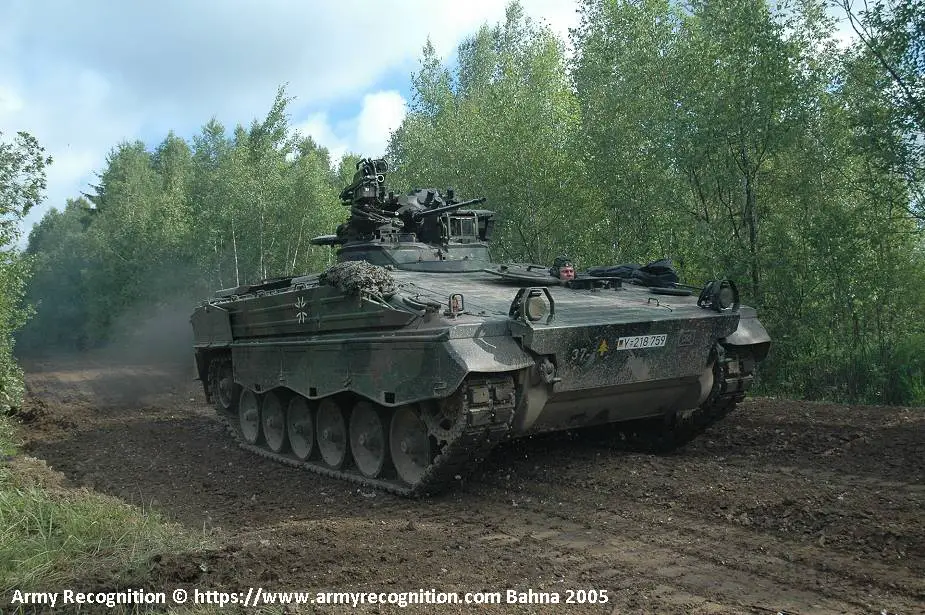
Description
The Marder 1A3 is an upgraded version of the Marder family of tracked armored Infantry Fighting Vehicles (IFV). The A3 upgrade program began in 1988, with Thyssen-Henschel being awarded a contract to upgrade 2,100 Marder 1 A1/A2 series vehicles to A3 standard at a rate of 220 vehicles a year. The first upgraded vehicles were delivered to the German army on 17 November 1989. In 2000, Thyssen-Henschel became Rheinmetall Landsysteme GmbH to continue the maintenance and upgrades of the Marder IFV family. The Marder 1A3 is the current standard IFV used by the German armed forces, but the new Puma IFV will replace it in the next few years. At the end of February 2022, the German company Rheinmetall had offered to deliver 100 Marder IFVs to Ukraine to fight the Russian invasion of February 2022, as well as the ammunition necessary for the use of the vehicle. On May 21, 2022, German media released that the German company Rheinmetall was preparing to deliver 100 Marder 1A3 to Ukraine. On October 18, 2022, the Hellenic National Defence General Staff announced the delivery of the first six Marder 1A3 to the Hellenic army. On November 23, 2022, German company Rheinmetall confirmed the delivery of the first Marder M1A3 IFVs to the Army of Greece. On January 6, 2023, Germany confirmed the delivery to Ukraine of 40 Marder IFVs. On January 13, 2023, Germany officially confirmed a plan to deliver 40 Marder IFVs to Ukraine. On March 4, 2023, citing information published by the German news magazine, "Der Spiegel," German company Rheinmetall is ready to supply Ukraine with 100 Marder 1A3 IFVs. On March 20, 2023, the German Ministry of Defense announced that the first Marder IFVs were on the way to Ukraine. In August 2020, the German Ministry of Defense announced the delivery of 40 more Marder 1A3 IFVs to Ukraine. On September 13, 2023, the German Ministry of Defense announced the delivery of 20 additional Marder IFVs to Ukraine. On November 22, 2023, the German Ministry of Defense announced the delivery of 20 additional Marder 1A3 IFVs to Ukraine. According to the latest information published by the German Ministry of Defense on October 17, 2024, Ukraine has received 140 Marder 1A3 IFVs since the beginning of the war in February 2022. In December 2024, the German Defense Company Rheinmetall received a new order for 20 Marder 1A3 for Ukraine.
Marder IFV variants:
- Marder 1 with Milan: a Milan launcher was fitted to all Marders between 1977 and 1979.
- Marder 1 A1(+) (1979–1982): dual-feed for 20 mm cannon enabling choice of ammunition, night vision equipment including image intensifiers, and a thermal imager. Infantry capacity reduced to five. Applied to 674 vehicles between 1979 and 1982.
- Marder 1 A1(-) (1979–1982): as A1(+) but without thermal imager. 350 vehicles upgraded to this standard.
- Marder 1 A1A3: a Marder A1 with SEM 80/90 cryptographic radios.
- Marder 1 A1A as 1 A1 but without any passive night vision equipment. 1,112 vehicles upgraded to this standard.
- Marder 1 A1A4: a Marder A1A with SEM 80/90 cryptographic radios.
- Marder 1 A1A2: a converted Marder 1 with an A1 turret and A2 chassis
- Marder 1 A1A5: a Marder A1A2 with SEM 80/90 cryptographic radios.
- Marder 1 A2 (1984–1991): Between 1984 and 1991, all German Marder 1s were upgraded to A2 standard, this included substantial modification of the suspension, fuel tanks, cooling system, and water-jet cleaning system. Additionally, a new sighting system was installed. The infrared searchlight equipment was removed, and all vehicles were fitted with thermal imagers except for the 674 A1(+) vehicles, which already had them.
- Marder 1 A2A1: a Marder 1 A2 with SEM 80/90 cryptographic radios.
- Marder 1 A3 (1988–1998)
- Marder 1 A4: a Marder 1 A3 with SEM 93 cryptographic radio.
- Marder 1 A5 (2003–2004): Additional anti-mine armor and completely remodeled interior in order to avoid blast and shock injuries to the crew when hit by a mine. Applied to 74 Marder 1 A3s only.
- Marder 1 A5A1 (2010–2011): Equipped with air conditioning system, jammer for IED (Improvised Explosive Device) protection, and multi-spectral camouflage. In December 2010 ten vehicles were brought to this standard, further 25 to be upgraded by August 2011.
Technical Data
| Armament |
|
The Marder 1A3 is fitted with a two-man turret with the commander on the right and the gunner on the left. The commander has a single-piece hatch cover that opens to the right while the gunner has a similar hatch cover that opens to the rear. The main armament of the vehicle consists of one 20 mm Rheinmetall MK 20 Rh202 automatic cannon mounted externally which has an elevation of +65º, depression of -17º, and 360º turret traverse. This cannon has a 1,000 rds/min rate of fire with an effective firing range of 2,500 m against ground targets and 1,600m against air targets. It is a fully automatic, gas-operated cannon with a floating mounted base, thus reducing the recoil forces and achieving maximum accuracy, long-range firepower, reliability, and service life. The second armament of the Marder 1A3 includes one 7.62 mm coaxial machine gun MG3 mounted to the right of the main armament. Two banks of three electrically operated 76 mm smoke grenade dischargers are mounted between the coaxial machine gun and the gun. On the right side of the turret, there is also a MILAN anti-tank guided missile launcher station operated by the commander with one missile ready to fire and six inside the vehicles. The latest generation of MILAN missiles has a maximum range of 3,000 m.
|
| Design and protection |
|
The general layout of the Marder 1A3 IFV is very similar to the previous version with the driver seat at the front of the hull on the left side, the engine compartment to the right of the driver, a two-man turret mounted in the forward part of the roof, and the troop's compartment at the rear. There is some modifications of the internal layout of the turret with ammunition feed, newly designed and improved seats, larger free space in the knee area, and an enlarged passage between the commander's and gunner's seats. The all-welded steel hull of the standard Marder 1 provides the crew with protection from small arms fire and shell splinters, with the front of the vehicle giving complete protection from 20 mm armor-piercing discarding sabot (APDS) projectiles. The Marder 1A3 is fitted with a new armor package providing protection against 30mm cannon ammunition. This package consists of frontal armor on the hull, add-on armor on the glacis plate, conformal add-on armor on both sides of the turret, three box-type armor components on both sides of the hull, spaced armor plates on the roof to cause premature detonation of top attack bomblets, add-on armor with a storage compartment at the rear door. Previous versions of the Marder IFV were fitted with two firing ports on each side of the hull but the Marder 1A3 does not have firing ports due to an extra layer of armor and outside storage boxes mounted on each side of the hull. The six infantrymen are seated in the troop compartment at the rear of the hull, three down each side facing outwards. One more seat is available at the rear area. The troops can leave and enter in the vehicle thanks to a power-operated ramp at the rear of the hull that opens downwards. New storage boxes are provided along the sides of the upper part of the hull.
|
| Mobility |
| The Marder 1A3 is motorized with an MTU MB 833 Ea-500 6-cylinder liquid-cooled diesel developing 600 hp at 2,200 rpm coupled to a 4-speed HSWL 194 planetary transmission with 4 forward and 2 reverse gears and integral steering and braking system. The 1A3 version uses a new improved suspension including the installation of reinforced torsion bars, a hydraulic duplex brake system, change of gear ratio of the lateral final drives to maintain high mobility. The torsion bar suspension on each side consists of six dual rubber-tired road wheels with the drive sprocket at the front, the idler at the rear, and three track return rollers. The first, second, fifth, and sixth road wheel stations have hydraulic shock absorbers. The Marder 1A3 can run at a maximum road speed of 65 km/h with a maximum cruising range of 500 km. The Marder can ford to a depth of 1.5 m without preparation or to 2.5 m with the aid of a kit. The Marder 1A3 can negotiate a gradient of 60% and side slopes of 30%. It can climb a vertical obstacle of 1 m and cross a trench of 2.5 m maximum. |
| Accessories |
| The standard equipment of the Marder 1A3 includes day periscopes, passive night vision devices, thermal sight, an air conditioning system, and NBC (Nuclear, Bacteriologic, Chemical) protection system. The diesel-electric air heating system of the standard Marder IFV has been replaced by a warm water heating system coupled and electrically linked to the engine cooling system. |
Specifications
| Armament | Armor |
| One 20mm MK 20 Rh202 automatic cannon, one 7.62mm MG3 coaxial machine gun one anti-tank guided missile launcher MILAN | Standard protection against firing of small arms 7.62mm caliber and shell splinters. For Marder 1A3 new armor package, protection against 30mm cannon ammunition |
| Country users | Weight |
| Chile, Germany, Greece, Indonesia, Jordania, Ukraine. | 33,500 kg |
| Designer Country | Speed |
| Germany | 65 km/h |
| Accessories | Range |
| Day periscopes, passive night vision devices, thermal sight, air conditioning system, and NBC protection system. | 500 km |
| Crew | Dimensions |
| 3 + 6 infantrymen | Length: 6.88 m; Width: 3.38 m; Height: 3.015 m |
Details View
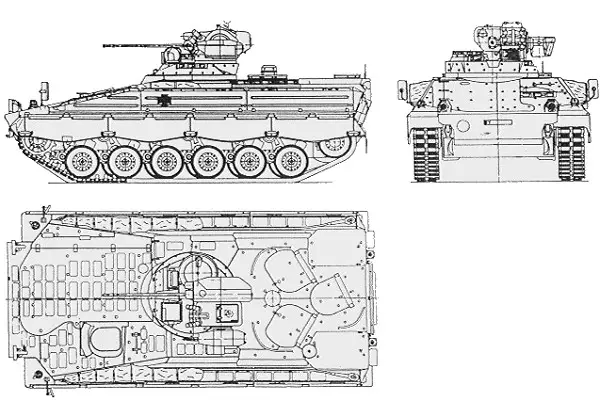 |
|
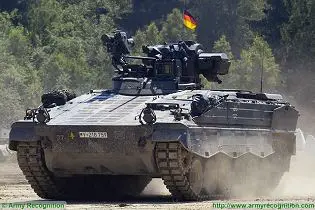 |
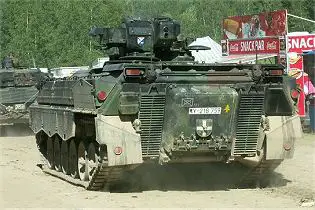 |
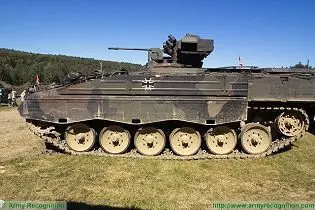 |
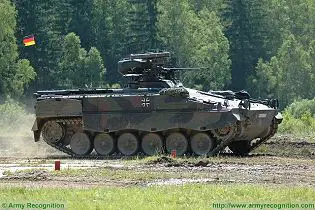 |
Pictures - Video



























